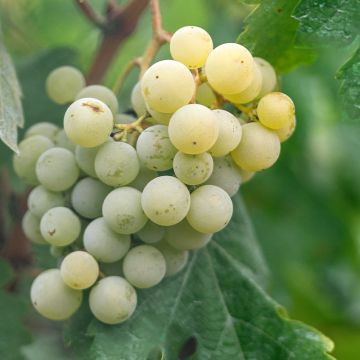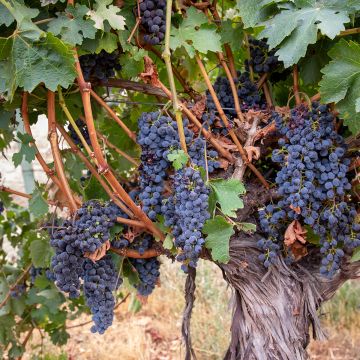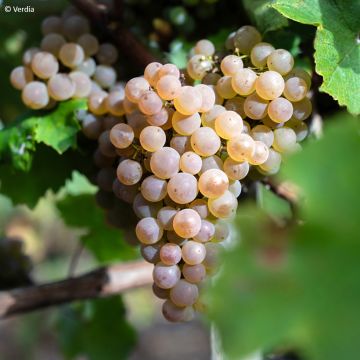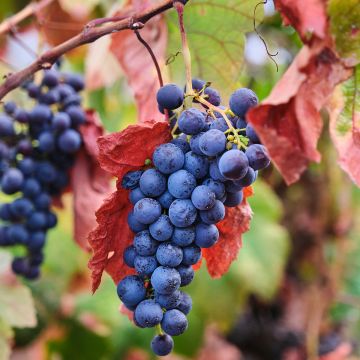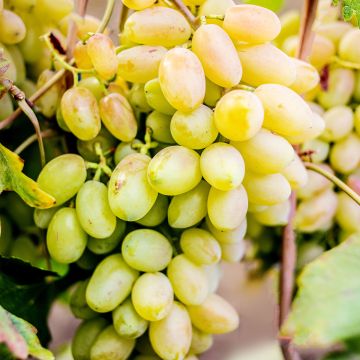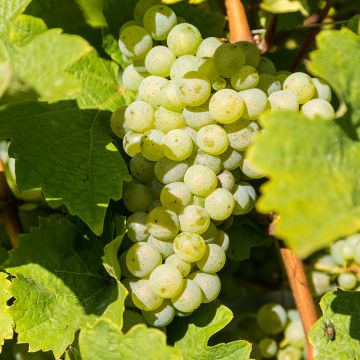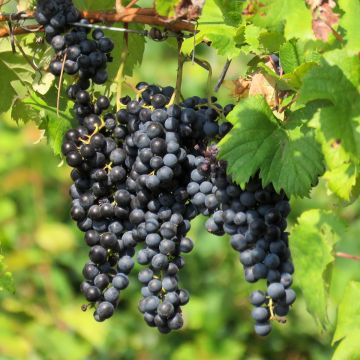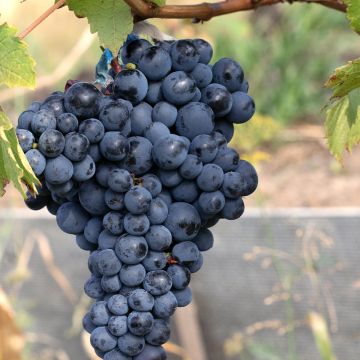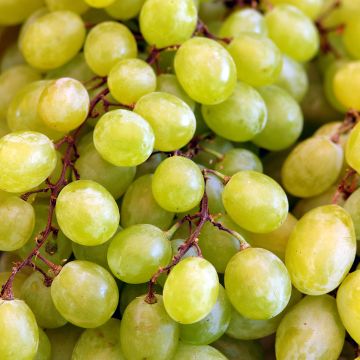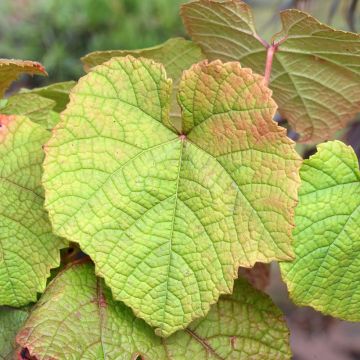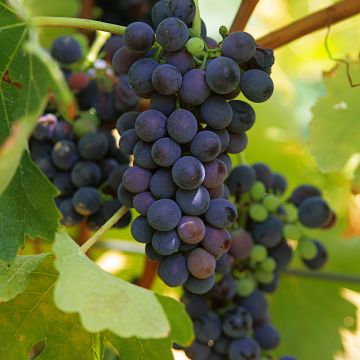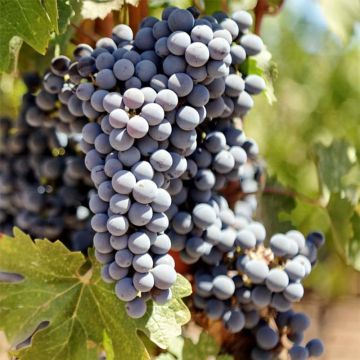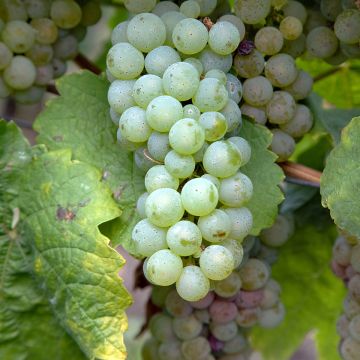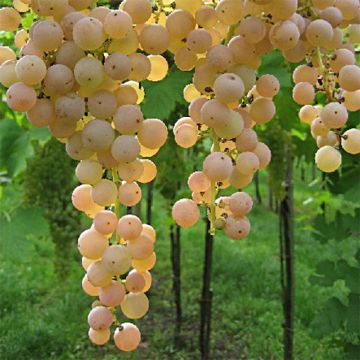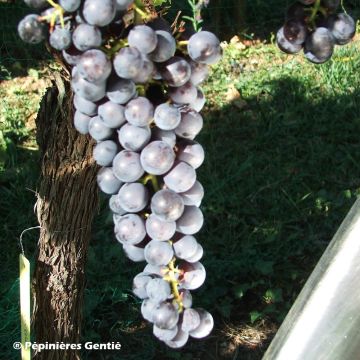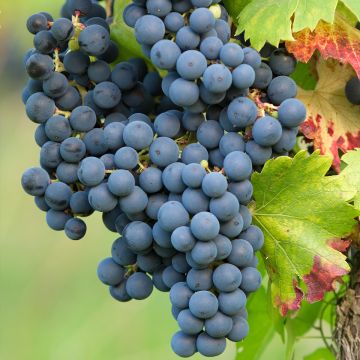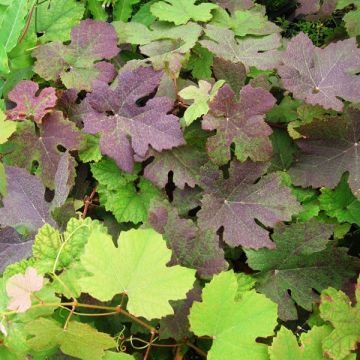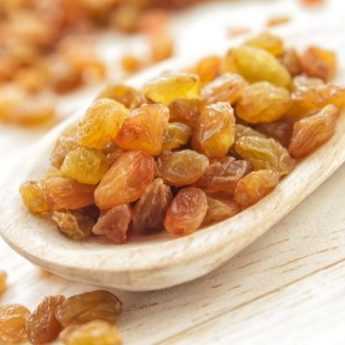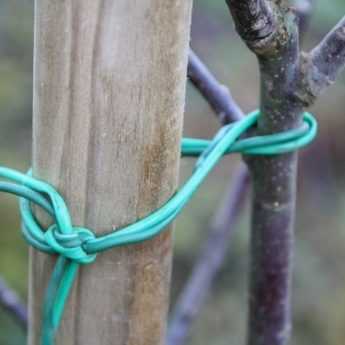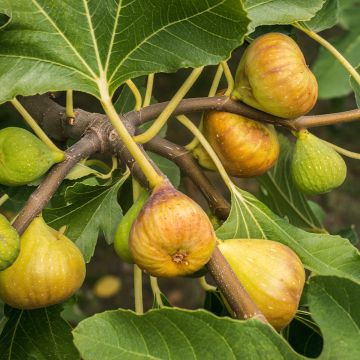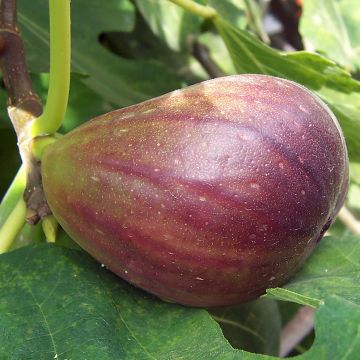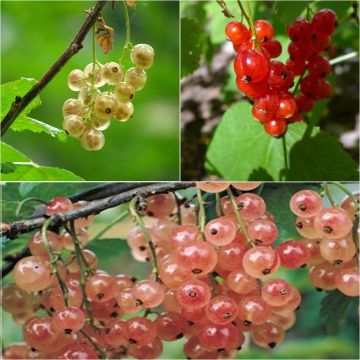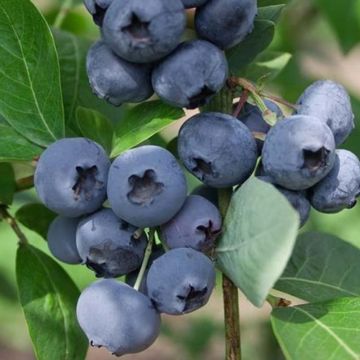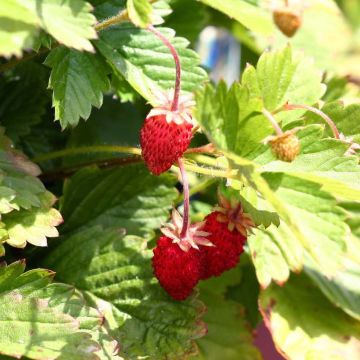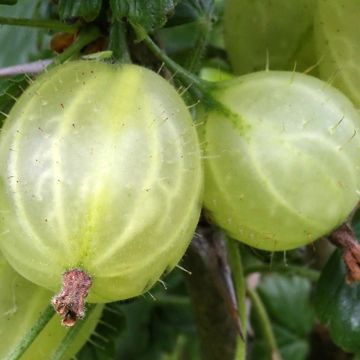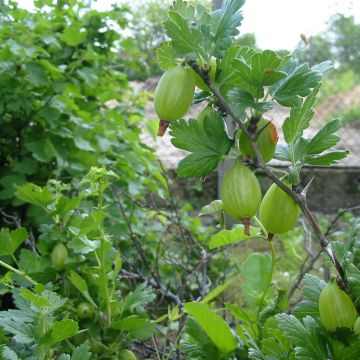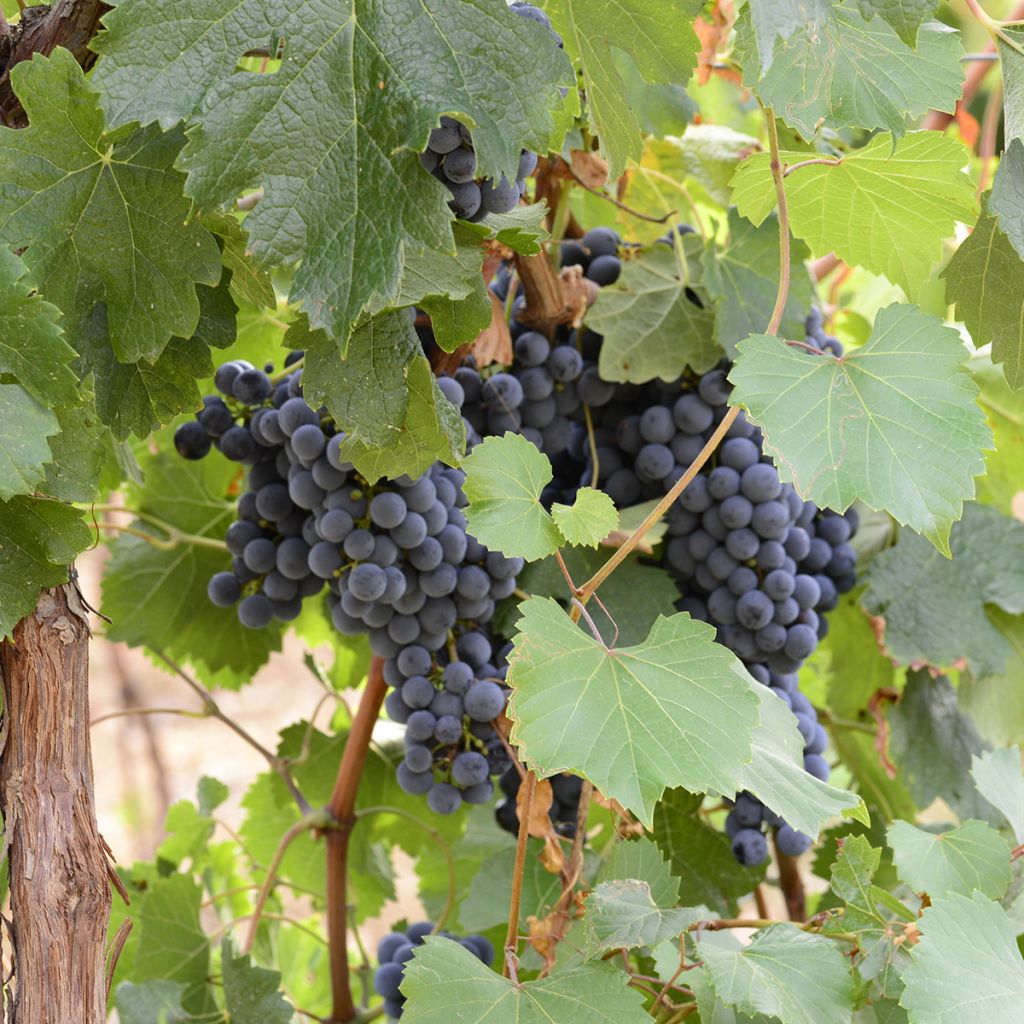

Vitis vinifera Bonarda - Grapevine
Vitis vinifera Bonarda - Grapevine
Vitis vinifera Bonarda
Common Grape Vine, European Grape, Wine Grape
Why not try an alternative variety in stock?
View all →This plant carries a 6 months recovery warranty
More information
We guarantee the quality of our plants for a full growing cycle, and will replace at our expense any plant that fails to recover under normal climatic and planting conditions.
Description
The 'Bonarda' vine, better known as 'Bonarda piemontese', is a black grape variety of Vitis vinifera that has been cultivated for a long time in the Piedmont region of Turin, on the hills of Chieri, near the cities of Asti, Alexandria, and Montferrat in northwest Italy. It is a moderately vigorous, rather late vine, traditionally used in blends with other grape varieties for the production of red wine. Its sweet grapes produce a fairly refined, tannic wine with fruity aromas, ruby red with violet reflections and medium alcohol content. It is a fairly late-ripening grape variety that is usually harvested in October.
The wine grape (Vitis vinifera) grew wild over 5000 years ago and belongs to the vitaceae family. Many hybrids have been created to vary colours, flavours, and uses. The 'Bonarda' vine is an Italian variety cultivated in many countries (Australia, Brazil, United States, Bulgaria, Ukraine, Switzerland).
A sarmentous shrub of medium vigour, the 'Bonarda' vine can reach up to 4m in height. Its final shape will depend on the pruning practised. The vine attaches itself to its support (trellis, espalier...) thanks to its tendrils and likes well-sunny situations. It has a strongly upright habit. It is advisable to train it on wire and trellis it well. This variety prefers a deep, clayey soil, rich in nutrients, and permeable. It will require short pruning, above 2 buds.
Its foliage is lightly lobed, wide, deep green in summer, turning yellow and brown in autumn before falling. Its flowering in clusters occurs in May-June, in panicles of tiny yellowish-green flowers. This variety produces medium to large, conical to pyramidal clusters, sometimes with 3 wings, more or less compact. Its grapes are medium-sized, round or slightly ovoid, covered with a thick, slightly tough skin, almost black in full ripeness and very powdery. Their flesh is soft, juicy, and sweet, producing a slightly coloured juice.
The 'Bonarda' variety is susceptible to powdery mildew and grape worms, but slightly less to downy mildew. It will need regular treatment, especially in humid climates. The plant will cling to any support available: fences, shrubs, and trees. It is wise to trellis it against a well-exposed stone wall so that it can make the most of the sun.
Grapes can be consumed as table fruit, fresh, but also in jams, jellies, fruit juice, pastries, and of course, after vinification, as wine. In general, grapes are rich in B vitamins, a source of fibre and manganese, and well-supplied with antioxidants. They are a healthy, natural, and tasty dessert.
Report an error about the product description
Plant habit
Fruit
Flowering
Foliage
Botanical data
Vitis
vinifera
Bonarda
Vitaceae
Common Grape Vine, European Grape, Wine Grape
Vitis vinifera Bonarda piémontèse, Bonarda di Asti, Bonarda nera, Bonarda di Caviglia, Bonarda à grandes grappes, Balsamina, Driola, Kanaiolo, Krasnyi, Negrin
Cultivar or hybrid
Other Grapevines
View all →Planting and care
Since the ravages of phylloxera at the end of the 19th century, the vine is grafted onto different rootstocks resistant to this disease and adapted to different types of soil. These rootstocks come from American varieties. Plant the Bonarda vine in autumn, in a deep, well-drained, even stony, arid, poor and chalky soil, in a well-sunny exposure, sheltered from strong winds. Incorporate 3 or 4 handfuls of fertiliser for fruit trees and 2 kg of composted manure into the planting soil for each vine-plant. The roots must not be in contact with the manure. After planting, prune above 2 large buds (buds) to obtain two branches. Keep the most vigorous one, and tie it to a stake. The pruning will follow.
Treat regularly with Bordeaux mixture between April-May and September to prevent cryptogamic diseases (mildew, powdery mildew...)
The vine does not require regular fertiliser for good yield, on the contrary. Enrich the soil with potash, crushed horn or iron chelate, only every 2-3 years.
Planting period
Intended location
Care
Planting & care advice
This item has not been reviewed yet - be the first to leave a review about it.
Similar products
Haven't found what you were looking for?
Hardiness is the lowest winter temperature a plant can endure without suffering serious damage or even dying. However, hardiness is affected by location (a sheltered area, such as a patio), protection (winter cover) and soil type (hardiness is improved by well-drained soil).

Photo Sharing Terms & Conditions
In order to encourage gardeners to interact and share their experiences, Promesse de fleurs offers various media enabling content to be uploaded onto its Site - in particular via the ‘Photo sharing’ module.
The User agrees to refrain from:
- Posting any content that is illegal, prejudicial, insulting, racist, inciteful to hatred, revisionist, contrary to public decency, that infringes on privacy or on the privacy rights of third parties, in particular the publicity rights of persons and goods, intellectual property rights, or the right to privacy.
- Submitting content on behalf of a third party;
- Impersonate the identity of a third party and/or publish any personal information about a third party;
In general, the User undertakes to refrain from any unethical behaviour.
All Content (in particular text, comments, files, images, photos, videos, creative works, etc.), which may be subject to property or intellectual property rights, image or other private rights, shall remain the property of the User, subject to the limited rights granted by the terms of the licence granted by Promesse de fleurs as stated below. Users are at liberty to publish or not to publish such Content on the Site, notably via the ‘Photo Sharing’ facility, and accept that this Content shall be made public and freely accessible, notably on the Internet.
Users further acknowledge, undertake to have ,and guarantee that they hold all necessary rights and permissions to publish such material on the Site, in particular with regard to the legislation in force pertaining to any privacy, property, intellectual property, image, or contractual rights, or rights of any other nature. By publishing such Content on the Site, Users acknowledge accepting full liability as publishers of the Content within the meaning of the law, and grant Promesse de fleurs, free of charge, an inclusive, worldwide licence for the said Content for the entire duration of its publication, including all reproduction, representation, up/downloading, displaying, performing, transmission, and storage rights.
Users also grant permission for their name to be linked to the Content and accept that this link may not always be made available.
By engaging in posting material, Users consent to their Content becoming automatically accessible on the Internet, in particular on other sites and/or blogs and/or web pages of the Promesse de fleurs site, including in particular social pages and the Promesse de fleurs catalogue.
Users may secure the removal of entrusted content free of charge by issuing a simple request via our contact form.
The flowering period indicated on our website applies to countries and regions located in USDA zone 8 (France, the United Kingdom, Ireland, the Netherlands, etc.)
It will vary according to where you live:
- In zones 9 to 10 (Italy, Spain, Greece, etc.), flowering will occur about 2 to 4 weeks earlier.
- In zones 6 to 7 (Germany, Poland, Slovenia, and lower mountainous regions), flowering will be delayed by 2 to 3 weeks.
- In zone 5 (Central Europe, Scandinavia), blooming will be delayed by 3 to 5 weeks.
In temperate climates, pruning of spring-flowering shrubs (forsythia, spireas, etc.) should be done just after flowering.
Pruning of summer-flowering shrubs (Indian Lilac, Perovskia, etc.) can be done in winter or spring.
In cold regions as well as with frost-sensitive plants, avoid pruning too early when severe frosts may still occur.
The planting period indicated on our website applies to countries and regions located in USDA zone 8 (France, United Kingdom, Ireland, Netherlands).
It will vary according to where you live:
- In Mediterranean zones (Marseille, Madrid, Milan, etc.), autumn and winter are the best planting periods.
- In continental zones (Strasbourg, Munich, Vienna, etc.), delay planting by 2 to 3 weeks in spring and bring it forward by 2 to 4 weeks in autumn.
- In mountainous regions (the Alps, Pyrenees, Carpathians, etc.), it is best to plant in late spring (May-June) or late summer (August-September).
The harvesting period indicated on our website applies to countries and regions in USDA zone 8 (France, England, Ireland, the Netherlands).
In colder areas (Scandinavia, Poland, Austria...) fruit and vegetable harvests are likely to be delayed by 3-4 weeks.
In warmer areas (Italy, Spain, Greece, etc.), harvesting will probably take place earlier, depending on weather conditions.
The sowing periods indicated on our website apply to countries and regions within USDA Zone 8 (France, UK, Ireland, Netherlands).
In colder areas (Scandinavia, Poland, Austria...), delay any outdoor sowing by 3-4 weeks, or sow under glass.
In warmer climes (Italy, Spain, Greece, etc.), bring outdoor sowing forward by a few weeks.



































